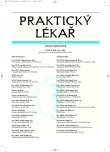Acute exacerbation of chronic obstructive pulmonary disease as seen by the intensivist
Authors:
R. Zazula
; A. Spálený
Authors‘ workplace:
Anesteziologicko-resuscitační klinika 1. lékařské fakulty
a Fakultní Thomayerovy nemocnice
; Přednosta: MUDr. Roman Zazula Ph. D.
; Univerzita Karlova v Praze
Published in:
Prakt. Lék. 2008; 88(8): 437-442
Category:
Reviews
Overview
Chronic obstructive pulmonary disease (COPD) is a major cause of mortality and chronic morbidity throughout the world; currently it is the fourth leading cause of death worldwide. The most common causes of acute COPD exacerbation, a frequent reason for hospital admission, include tracheobronchial tree infection, climatic changes, and patient non-compliance. This review outlines the basic pathophysiological characteristics of COPD exacerbation and indication criteria for patient hospitalization in a routine care ward or an ICU. Principles of comprehensive conservative therapy and strategies of invasive and non-invasive ventilatory support are outlined, including current concepts of a potential reduction of respiratory work by administering a mixture of helium and oxygen (heliox) in acute respiratory failure.
Key words:
COPD, respiratory insufficiency, mechanical ventilation, heliox.
Sources
1. Černý, V. Neinvazivní plicní ventilace. In: Dostál, P. a kol. Základy umělé plicní ventilace. Praha 2004: Nakladatelství Maxdorf, 273 s. ISBN 80-7345-007-0.
2. Dostál, P. Možnosti umělé plicní ventilace u nemocných s exacerbací chronické obstrukční plicní nemoci. In: Zazula R.: Ročenka intenzivní medicíny 2005, Galén Praha 2005, s. 12-15.
3. Fink, J.B. Helium-oxygen: An old therapy creates new interest. RT Magazine, 1999, 4. Dostupný také z WWW: 4. Chevrolet, J.C. Helium oxygen mixtures in the intensive care unit. Critical Care Med. 2001, 5(4), p. 179-181.
5. Jindrák, V. Strategie ATB léčby u pacienta s chronickým respiračním onemocněním. In: Zazula R.: Ročenka intenzivní medicíny 2005, Galén Praha 2005, s. 16-20.
6. Jolliet, P., Tassaux, D., Roeseler, J. et al. Helium-oxygen versus air-oxygen noninvasive pressure support in decompensated chronic obstructive disease: A prospective, multicenter study. Critical Care Med, 2003, 31 (3), p. 878-884.
7. Keenan, S.P., Sinuff, T., Cook, D.J., Hill, N.S. Which patients with acute exacerbation of chronic obstructive pulmonary disease benefit from non-invasive positive-pressure ventilation? A systematic review of the literature. Ann. Intern. Med. 2003, 138, p. 861-870.
8. Kolek, V. Chronická kolonizace bronchiální sliznice u CHOPN. In: Drábková, J. a kol. Péče o nemocné chronickou obstrukční plicní nemocí v České republice. 1. vyd. Praha: Nakladatelství Jalna, 1996. 176 s. ISBN 80-901743-3-7.
9. Lee, D.L., Lee, H., Chang, H.W. et al. Heliox improves hemodynamics in mechanically ventilated patients with chronic obstructive pulmonary disease with systolic pressure variations. Critical Care Med. 2005, 33 (5), 968-973.
10. Lichtowler, J.V., Wedzicha, J.A., Elliot, M.W. et al. Non-invasive positive pressure ventilation to treat respiratory failure resulting from exacerbation of chronic obstructive pulmonary disease: Cochrane systematic review and meta-analysis. BMJ, 2003, 326, p. 185-189.
11. Musil, J. Exacerbace chronické obstrukční plicní nemoci – pohled pneumologa. In: Zazula R.: Ročenka intenzivní medicíny 2005. Praha: Galén 2005, s. 7-11.
12. Musil, J., Kos, S., Vondra, V., Salajka, F. Světová strategie diagnostiky, léčby a prevence CHOPN. 1.vyd. Praha: Nakladatelství Vltavín, 2007. 164 s. ISBN 80-86587-22-3.
13. Nava, S., Ceriana, P. Cause of failure of nonivasive mechanical ventilation. Respir. Care, 2004, 49, p. 295-303.
14. Pařízková, R. Kortikoidy v intenzivní péči, nadledvinová insuficience. Anest. intenziv. Med. 2005, 16, 1, s. 43-49.
Labels
General practitioner for children and adolescents General practitioner for adultsArticle was published in
General Practitioner

2008 Issue 8
- Metamizole vs. Tramadol in Postoperative Analgesia
- Metamizole at a Glance and in Practice – Effective Non-Opioid Analgesic for All Ages
- Memantine in Dementia Therapy – Current Findings and Possible Future Applications
- Possibilities of Using Metamizole in the Treatment of Acute Primary Headaches
- Hope Awakens with Early Diagnosis of Parkinson's Disease Based on Skin Odor
Most read in this issue
- Chronic damage of the triangular fibrocartilage complex
- Acute facial palsy – a comparison of clinical and laboratory parameters in patients with Borrelia and idiopathic aetiology
- Stenosis of the left subclavian artery as a cause of angina pectoris progression after CABG: coronary-subclavian steal syndrome
- Acute exacerbation of chronic obstructive pulmonary disease as seen by the intensivist
